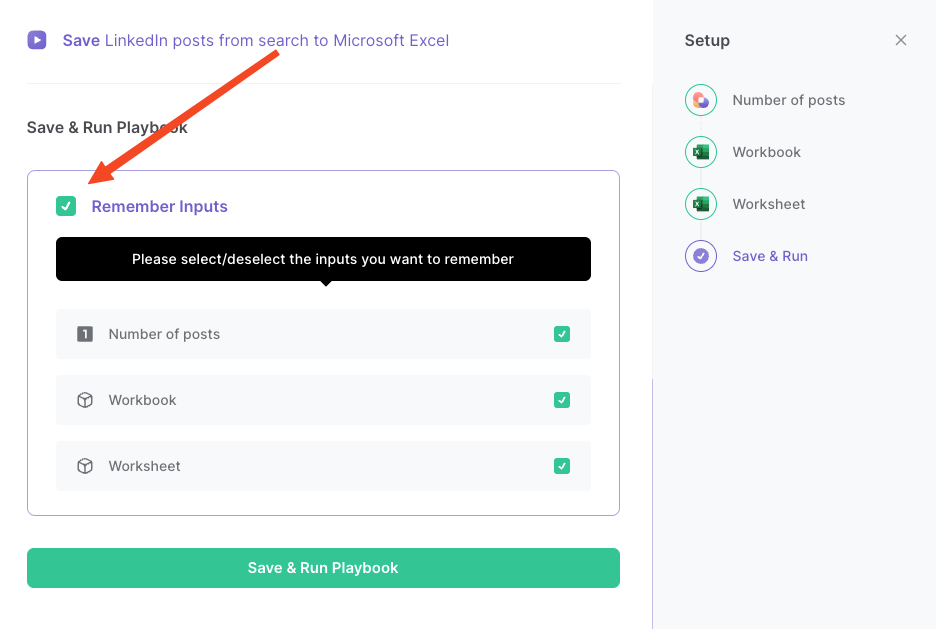Save LinkedIn posts from search to Microsoft Excel
This is a Bardeen playbook. It's a pre-built automation template you can run in one-click to perform a repetitive task. Get started with our free Chrome extension.
Explore other automations
This playbook has been deprecated.
Explore Bardeen's playbook catalog for other automations or build your own.

How does this automation work?
How to run the playbook
Ready to level up your LinkedIn analytics? Our playbook has you covered. It efficiently extracts a specified number of LinkedIn posts from the currently opened post search page, compiling them along with comments, reactions, and repost data into a Microsoft Excel Workbook.
Manually gathering post data from LinkedIn searches can be time-consuming and prone to errors. With our playbook, you can effortlessly collect and analyze valuable insights for your LinkedIn strategy.
Imagine having a comprehensive Excel workbook filled with detailed post analytics, including engagement metrics, audience feedback, and post performance. Whether you're tracking the success of your content, analyzing competitor activity, or refining your social media marketing strategy, this automation simplifies the process, saving you time and providing valuable insights to enhance your LinkedIn presence.
Let’s set it up!
Please be aware that the excessive or abusive use of extensions, bots, or automation tools on some websites can lead to penalties, including temporary or even permanent restrictions on your account. We recommend you read and adhere to the specific terms of the websites you are visiting and using to avoid any disruptions or issues. We do not assume any responsibility for the consequences of abuse.
Step 1: Pin the playbook and integrate Microsoft Excel
First, click the “Pin it” button at the top of this page to save this automation. You will be redirected to install the browser extension when you run it for the first time. Bardeen will also prompt you to integrate Microsoft Excel.
Activate Bardeen (or hit Option + B on Mac or ALT + B on PC on your keyboard) and click on the playbook card. The setup flow will start. Bardeen will ask you to specify a Microsoft Excel spreadsheet, and the maximum number of posts you would like to extract and summarize. You can choose an existing Microsoft Excel sheet or create a new one.

Click on “Save Input” and checkmark the maximum number of posts and the Microsoft Excel spreadsheet. This will save you time from setup in the future. You can edit Inputs later by hovering over the playbook.

Step 2: Run the playbook and save LinkedIn posts from search to Microsoft Excel
When you want to save LinkedIn posts and get information like comments, reactions, and repost data of each post, navigate to the LinkedIn post search results page.

Activate Bardeen (or hit Option + B on Mac or ALT + B on PC on your keyboard) and run this playbook. It will extract a specified number of LinkedIn posts from the currently opened LinkedIn post search page, and add the posts, along with comments, reactions, and repost data, to your Microsoft Excel Workbook.

Your proactive teammate — doing the busywork to save you time
.svg)
Integrate your apps and websites
Use data and events in one app to automate another. Bardeen supports an increasing library of powerful integrations.
.svg)
Perform tasks & actions
Bardeen completes tasks in apps and websites you use for work, so you don't have to - filling forms, sending messages, or even crafting detailed reports.
.svg)
Combine it all to create workflows
Workflows are a series of actions triggered by you or a change in a connected app. They automate repetitive tasks you normally perform manually - saving you time.
FAQs
You can create a Bardeen Playbook to scrape data from a website and then send that data as an email attachment.
Unfortunately, Bardeen is not able to download videos to your computer.
Exporting data (ex: scraped data or app data) from Bardeen to Google Sheets is possible with our action to “Add Rows to Google Sheets”.
There isn't a specific AI use case available for automatically recording and summarizing meetings at the moment
Please follow the following steps to edit an action in a Playbook or Autobook.
Cases like this require you to scrape the links to the sections and use the background scraper to get details from every section.








